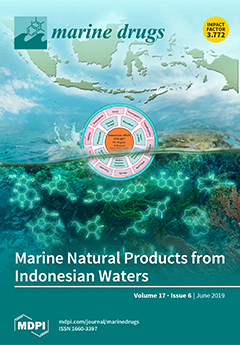Modulation of multiple protein targets with a single compound is essential for the effective treatment of central nervous system disorders. In our previous G protein-coupled receptor (GPCR) cell-based study, a selective human monoamine oxidase (
hMAO)-A inhibitor, eckol, stimulated activity of dopamine
[...] Read more.
Modulation of multiple protein targets with a single compound is essential for the effective treatment of central nervous system disorders. In our previous G protein-coupled receptor (GPCR) cell-based study, a selective human monoamine oxidase (
hMAO)-A inhibitor, eckol, stimulated activity of dopamine D
3 and D
4 receptors. This result led to our interest in marine phlorotannin-mediated modulation of
hMAO enzymes and related GPCRs in neuronal disorders. Here, we evaluate the multi-target effects of phloroglucinol, phlorofucofuroeckol-A (PFF-A), and dieckol by screening their modulatory activity against
hMAO-A and -B and various neuronal GPCRs. Among the tested phlorotannins, PFF-A showed the strongest inhibitory activity against both
hMAO isoforms, with higher selectivity toward
hMAO-B than
hMAO-A. Enzyme kinetics and docking data revealed that PFF-A noncompetitively acts on
hMAOs into the alternative binding pocket of enzymes with allosteric functions. In a functional assay for GPCR screening, dieckol and PFF-A exhibited a multi-target combination of D
3R/D
4R agonism and D
1/5HT
1A/NK
1 antagonism. In particular, they effectively stimulated D
3R and D
4R, compared to other GPCRs. Docking analysis confirmed that dieckol and PFF-A successfully docked into the conserved active sites of D
3R and D
4R and interacted with aspartyl and serine residues in the orthosteric binding pockets of the respective receptors. Based on our experimental and computational data, we established the structure-activity relationship between tested phlorotannins and target proteins, including
hMAOs and GPCRs. Our current findings suggest that
hMAO inhibitors dieckol and PFF-A, major phlorotannins of edible brown algae with multi-action on GPCRs, are potential agents for treatment of psychological disorders and Parkinson’s disease.
Full article






